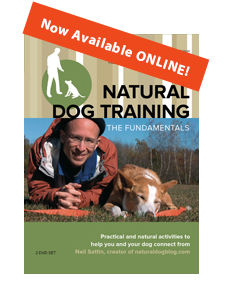Along with doggie aggression, one of the most common issues that people have with their dogs is behavior that we would translate as "separation anxiety". You leave the house, and your dog goes on a rampage - digging, chewing, barking, howling, etc. - much to your chagrin upon your return. We could spend all sorts of time on psychological analysis of the issue, but at the heart of the matter doggie separation anxiety is like other problems that we've addressed. In essence, when you leave your dog alone, your dog experiences a surge of energy, and your dog doesn't know quite what to do with that energy. So it comes out in all the ways I just mentioned. We're going to talk about how to address separation anxiety the "Natural Dog Training" way, along with a few miscellaneous tips thrown in for your "working with an opportunity dog" toolbox.
Separation Anxiety represents two problems
The first problem that separation anxiety represents is a misplaced answer to the primary question your dog is asking: "What do I do with my energy?" The second question that your dog needs to have answered is "Where is the danger?" - because without an answer to that question the danger could be, literally, anywhere. We're going to address these two questions separately - first the energy, then, in a later post, the danger.
Fortunately for those of you who have been following the step-by-step Natural Dog Training methods, you have been teaching your dog what to do with all of that energy that they get from the world. Recall that the prey drive is your dog's way of venting the stress that they've stored up in their experience of the universe. Therefore, the more you can help your dog vent their stress through your play and training (and your presence), the less stress there is to be mobilized in your absence. So that's a more and more solid foundation. Even so, here are some tips designed specifically for transforming the symptoms of separation anxiety in your dog.
- Consistent time devoted to satisfying your dog's prey drive. Frequently the act of simply giving consistent time to the prey drive (e.g. through pushing and tug games) will have a curative effect on separation anxiety. You are giving your dog a specific context for when to vent their stress (as opposed to a separation anxiety situation, where the stress is vented however it occurs to them to vent it).
- Working on the down/stay. Teaching a solid down-stay IN DRIVE will also help give a dog the ability to feel settled (despite feeling charged up). Imagine a dog, at home, in the crate - who would normally start to get worked up (separation anxiety) but who now has a new way to "feel" in that situation. Lying down becomes a relief from stress in this situation, because your down/stay work has set up a new pattern, where down/stay is harmonious with an energized state - and a way to resolve the flow of energy (as opposed to the dysfunctional "anxiety" behavior).
- Crate Training. As alluded to in #2, generally placing your dog in a crate while you're gone can be an important part of your dog's overcoming separation anxiety. Give your dog something that they CAN chew in the crate (like a real marrow bone), make sure the crate is dark and protected - a place where your dog can feel safe (as opposed to an open wire-mesh crate where a dog would feel vulnerable). The crate provides structure to the dogs space, and if it's small enough (sized appropriately) it will prevent soiling issues, all the while keeping the dog out of trouble.
- Set up a pattern for your coming/going that will become familiar to your dog. Take your dog out and satisfy their prey drive before you leave. Upon your RETURN, keep things initially RELAXED and low-key, perhaps even leaving your dog in the crate for 10-15 minutes and ignoring them so they can settle down (adjusting to your return). Then head outside for another play session, to vent any of the remaining stress your dog might be experiencing from your absence. Your dog will get used to the pattern, which will offer them additional reassurance during times of solitude.
- Inside = Quiet. Outside = Play. Your dog's ability to stay relaxed when they are alone in the house is dependent upon your ability to set up this dynamic for them. No play in the house - only play outside. Inside is exclusively for relaxation.
- Make a CD to "remind" your dog of your presence...during your absence. Not exactly a Natural Dog Training tip, but a friend of mine added this to the mix: he made a recording of himself around the house, just going about his day, taking a shower, telling a quiet, relaxing bed-time story to his dog, talking to his dog in a calming voice. He burned that to a CD, and then played it on repeat while he was away. It gave his dog something relaxing and familiar to listen to while he was gone, and it definitely seemed to help ease the separation anxiety symptoms.
- Relax. Yo - I'm talking to you! Your dog is paying attention to the emotional signals you're sending. Are you stressed out about leaving your dog home alone for some reason? Do YOU have separation anxiety? Take a breath, relax, and maintain positive energy. Develop your own confidence that everything is fine, and that the separation anxiety problem will disappear all in good time. Focus on the positive reasons for "time alone" as well as time together. OK, I'm no psychologist. Enough said.
- Start small - be gradual. As with anything, aim for initial small successes (quick time away), and gradually build to longer durations of time.
There are rarely instant cures for behavioral issues that a dog experiences. However, dogs are resilient creatures, and naturally gravitate towards emotional states that feel good: being relaxed and in the flow. A dog with separation anxiety has already set up a certain way of handling the stress of your absence - but in time you will teach your dog a NEW way to respond that will feel better to them. The strategies that we have discussed cover the times before and after your absence (venting stored stress, helping your dog to a point of emotional satiation through the prey drive), as well as while you're gone (structuring your dog's space, and giving them something tasty to chew on as a healthy outlet for residual anxiety). Stay patient, keep it gradual, and watch your dog transform.





DAP. (Dog Appeasing Pheromone)
Neil, I did some DAP research a while back, and found mixed outcomes, but it also seems worth a try, particularly if a crate is being used, along with a DAP collar and plug-in unit in a room that doesn't circulate air (such as central air or forced hot air heat which is constantly introducing air from another part of the house and diluting the DAP).
I think the down-stay in drive is a critical component and I'm so glad you've given us the tutorials to get there.
I dealt with separation anxiety in my first dog. Unfortunately, your tips would not have worked for me -- they may work for some, because there are different degrees of separation anxiety. I consulted with a respected dog trainer, too, and that didn't help either.
The key for me was to never leave him alone for longer than he could handle while I was working on desensitizing him to being left alone.
I had been working on desensitizing him for months, but everytime I left for longer than he could handle (which was maybe a minute or less in the beginning), it just destroyed all the work I'd done.
It was a slow, tedious process, but it worked. Now I have a dog who gets so excited when I'm about to leave -- and because I don't work outside the home, I don't have set hours when I'm gone -- that he will run right into his crate.
In fact, I sometimes I have to be very careful not to give him signals that I'm leaving, or he won't do anything when I take him outside to do his business before I leave, because he's so focused on the chew he'll get while I'm gone.
I will have to ponder your advice not to allow play in the house. It seems sound, but then you have days like we're having today -- lots of rain (not to mention those who live in cold, snowy environments) -- how will they burn off their energy if they can't be outside for long?
There are varying degrees of separation anxiety, and different things work for different dogs, as with any training. While my dog wasn't destructive when I was gone, he'd have accidents and he wouldn't touch food; he wouldn't settle at all and would howl almost the entire time.
Months and months of desensitizing didn't work. But within two months of working hard and not leaving him alone for longer than he could handle he was a different dog.
Hi Angelique,
I haven't had any experience with DAP, so I'm glad that you added that to the mix.
Hey Judy,
Thanks for stopping by! The final step (#8 - start small, be gradual) was meant to address the very thing that you mentioned - working on your dog's successes, taking them only as far as they can go, slowly building up to longer periods away. I'm glad you placed extra emphasis on that point in your comment.
Oh, and regarding the "what do you do when the weather's bad" - a couple things. First - make sure that you have really good inclement weather gear - and use it! Second - when your dog gets used to the "indoors I am really relaxed and outside is where I play" dynamic, your dog, in general will tend to be less "wound up" inside, saving that intensity for outdoor activity. The engine revving inside (without a satisfactory outlet) is a contributor to the symptoms of separation anxiety. Hope that makes sense.
I live in a climate where this week with wind chill it hit minus 28 celsius (-18 fahrenheit). A warm coat, thick boots, gloves, hat, and a vigorous game of fetch, tug, and push keeps both my dog and I warm in that weather.